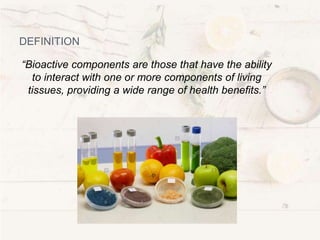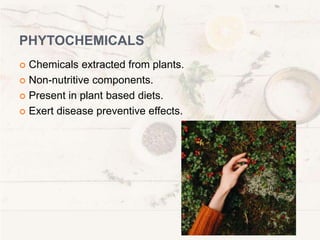herbs, food and phytochemicals
- 3. CONTENTS ÔÇ¢ Herbs. ÔÇ¢ Food. ÔÇ¢ Functional foods. ÔÇ¢ Bioactive components. ÔÇ¢ Phytochemicals. ÔÇ¢ Terminologies.
- 4. HERBS ÔÇ¢ Green leafy parts of plants ÔÇ¢ They lack woody stems ÔÇ¢ Mostly used for: ÔÇó Flavoring ÔÇó Medicinal purposes
- 5. CYCLOOXYGENASE ENZYME ÔÇ¢ Acts as a catalyst in case of infectious reactions ÔÇ¢ Herbs inhibit this enzyme
- 6. FOOD “Materials, raw or processed or formulated that are consumed orally by humans or animals for growth, health, satisfaction, pleasure and satisfaction of social needs,”
- 7. FUNCTIONAL FOODS “Any food that provides additional health benefits besides providing basic physiological functions.”
- 8. CONT. ÔÇ¢ Provides basic nutrition ÔÇ¢ provides physiological health benefits ÔÇ¢ Includes: ÔÇó Grapes ÔÇó Berries ÔÇó Tomatoes ÔÇó Garlic ÔÇó Onion
- 9. DOSE SPECIFIC ÔÇ¢ Food is not toxic, the dose makes it toxic. ÔÇ¢ E.g. more than one pinch of turmeric.
- 10. BIOACTIVE COMPONENTS ÔÇ¢ Produce disease preventing effect in phytochemicals. ÔÇ¢ The specific component in the food that play role in health benefits.
- 11. DEFINITION “Bioactive components are those that have the ability to interact with one or more components of living tissues, providing a wide range of health benefits.”
- 12. EXAMPLE ÔÇ¢ Lycopene: ÔÇó Bioactive component of tomato ÔÇó Anti-oxidant
- 13. CONT.  Allyl Sulphide:  Bioactive component of garlic/ onion family  Causes blood thinning  Prevent CVD’s  Anti-cancer effects
- 14. CONT. ÔÇ¢ Anthocyanin: ÔÇó Present in berries. ÔÇó Antioxidant.
- 15. PHYTOCHEMICALS ÔÇ¢ Chemicals extracted from plants. ÔÇ¢ Non-nutritive components. ÔÇ¢ Present in plant based diets. ÔÇ¢ Exert disease preventive effects.
- 16. CLASSES OF PHYTOCHEMICALS ÔÇ¢ Triterpenoids: ÔÇó Polyterpenoids ÔÇó Carotenoids ÔÇ¢ Phenolic acids: ÔÇó Flavenoids ÔÇó Tannins ÔÇó Liganins ÔÇó Xanthones
- 17. CONT. ÔÇ¢ Alkanoids: ÔÇó Betanins ÔÇó Glucosinulates ÔÇó Amino acids ÔÇó Purines
- 18. TERMINOLOGIES ÔÇ¢ Antispasmodic: ÔÇó To give relief against muscle spasm. ÔÇ¢ Carminative: ÔÇó Flatulence relief. ÔÇ¢ Diaphoretic: ÔÇó Heavily sweating. ÔÇ¢ Analgesic: ÔÇó Painkillers.
- 19. CONT. ÔÇ¢ Aphrodisiac: ÔÇó Increase sexual drive. ÔÇ¢ Antiseptic: ÔÇó Germ killers. ÔÇ¢ Deodorant: ÔÇó Emit bad odors. ÔÇó Fragrance purpose. ÔÇ¢ Lypolytic: ÔÇó Causes breakdown of fat



















